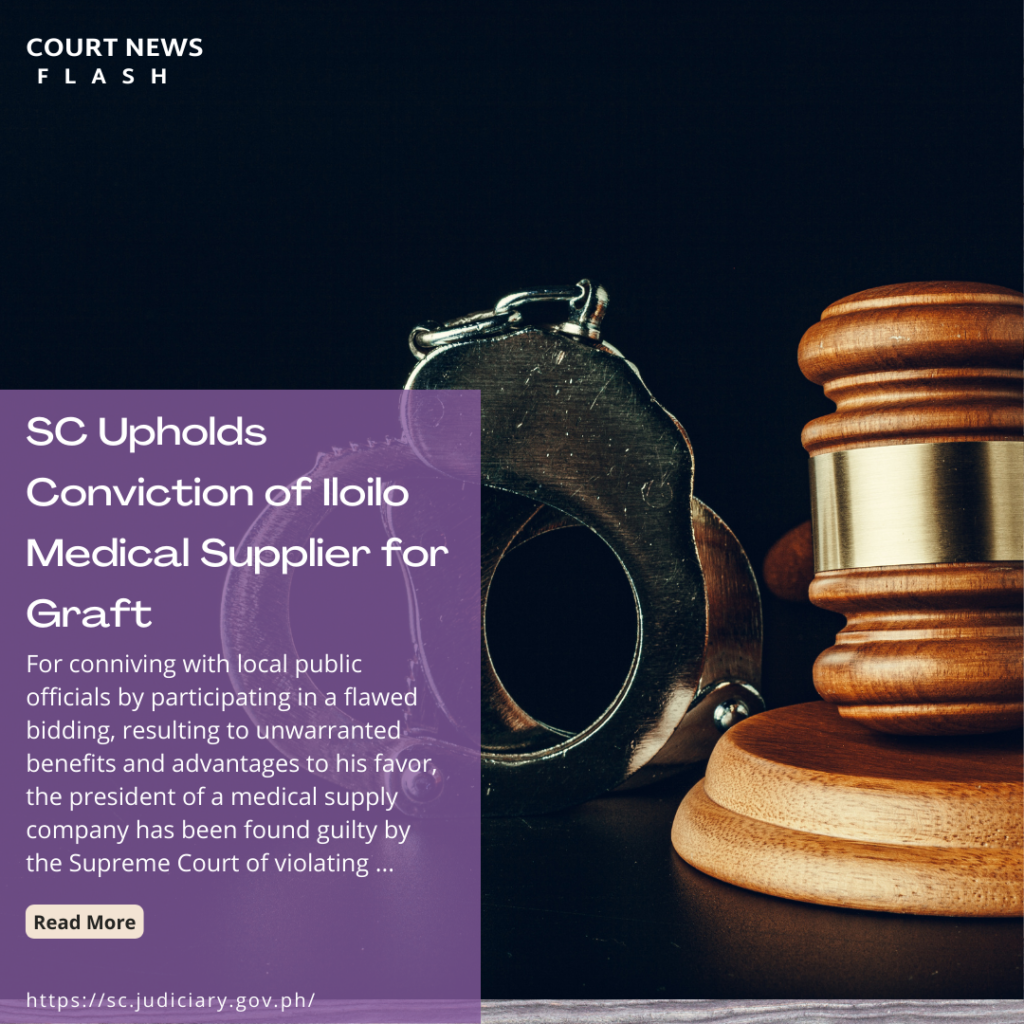For conniving with local public officials by participating in a flawed bidding, resulting to unwarranted benefits and advantages to his favor, the president of a medical supply company has been found guilty by the Supreme Court of violating Republic Act No. 3019 (RA 3019), or the Anti Graft and Corrupt Practices Act.
In a 19-page Decision penned by Justice Ramon Paul L. Hernando, the Court denied the petition for review on certiorari filed by Rodrigo D. Villanueva, President and General Manager of AM-Europharma Corporation (Europharma), and affirmed the rulings of the Sandiganbayan which found Villanueva guilty of violating Section 3 (e) of RA 3019.
Section 3 (e) of RA 3019 provides that “causing any undue injury to any party, including the Government, or giving any private party any unwarranted benefits, advantage or preference in the discharge of his official, administrative or judicial functions through manifest partiality, evident bad faith or gross inexcusable negligence” shall constitute corrupt practices of any public officer and are declared unlawful.
Villanueva and several local government officials of the Municipality of Janiuay, Iloilo were charged by the Office of the Ombudsman with violation of RA 3019 for allegedly conniving with each other for the purchase of medicines worth P13,191,223.00 from Europharma, notwithstanding the fact its accreditation was still pending with the Department of Health (DOH) when it was awarded the contract, thus disqualifying it from bidding. It was also alleged that Villanueva was the sole proprietor of Mallix Drug Center (Mallix), a supplier which participated in the same public bidding and was awarded P1,744,926.
In addition, the drug delivered by cotrimoxazole, worth P240,000, delivered by Europharma and Mallix failed the medical analysis conducted by the Bureau of Food and Drugs.
The Sandiganbayan held that all the accused conspired with each other and were guilty of violation of Section 3 (e) of RA 3019 for awarding the contracts for the purchase of medicines to the business entities of petitioner. It found that the undue haste in the delivery of the medical supplies, and the speed by which the payments were made, even without the required 10% performance bond, and the irregularities found in the qualification and accreditation of both Europharma and Mallix Drug “reveal the manifest partiality and evident bad faith” of the public officials and of Villanueva. The Sandiganbayan found that Villanueva conspired with his fellow accused in the perpetuation of the crime charged based on his conduct prior, during, and after the bidding.
Denying Villanueva’s petition for review of the Sandiganbayan’s Decision, the Court found that the prosecution satisfactorily established that there was a failure of bidding, since at the time of the public bidding on January 15, 2001, the accreditation of Europharma and another bidder were still suspended by the DOH. The Court said that Villanueva could not take refuge on his claim that a competitive bidding may be dispensed with as the transactions were under “Emergency Purchase” since the requisites of Section 36 of the Local Government Code were not present.
The Court disagreed with Villanueva’s argument that he was not liable under RA 3019 as there was no damage or actual injury on the Government or any of its instrumentalities.
Quoting the Sandiganbayan Decision, it stressed that there are two ways by which a public official violates Section 3 (e) of RA 3019: by causing undue injury to any party, including the Government, or by giving any private party unwarranted benefits, advantage, or preference. The accused may be charged under either way, or under both. The presence of one way would suffice for conviction.
The Court also emphasized that private individuals such as Villanueva can be liable together with public officials if conspiracy is proven, and that piercing the fiction of corporate veil is allowed if juridical entities are used by private individuals as vehicles to commit illegal acts.
It affirmed the ruling of the Sandiganbayan that while no law prohibited Villanueva’s companies from participating in one and the same bidding under the principle that they are clothed with personalities separate from the persons composing them, the fact that Villanueva used his companies as means or vehicles for circumventing the laws on procurement of government supplies through competitive bidding “by combining his companies in the bidding, not only to get the desired price but also in order to assure that one or both of them can get the award” should not be countenanced.
The Court found that the two companies owned by Villanueva which participated in the failed bidding were “alter egos” of each other as the corporate documents of the entitites reveal Villanueva’s ownership and almost absolute control over Europharma, and that Mallix had no juridical personality separate and distinct from Villanueva.
“Clearly, petitioner’s attempt to use the corporate fiction of Europharma as a shield from liability is not proper,” the Court concluded.
FULL TEXT of G.R. No. 218652 at https://sc.judiciary.gov.ph/28457/













